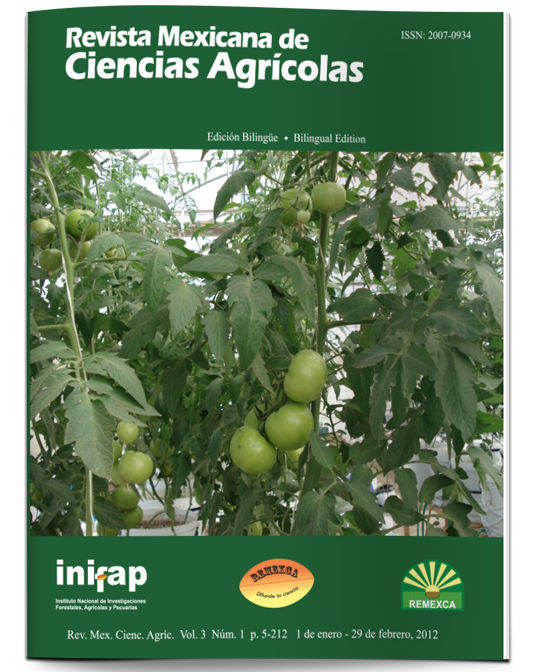Morphological leaf adaptations in tomato grown in warm retractable-roof bio-space
DOI:
https://doi.org/10.29312/remexca.v3i1.1491Keywords:
Solanum lycopersicum, shade-house, sustainable glasshouse, SASAbstract
Microclimatic conditions and indeterminate tomato leaf morphology of two bio-spaces were analyzed: retractable- roof greenhouse and shade-house in Culiacán, Sinaloa, Mexico, during the period 2009 - 2010. The results show that, the retractable-roof greenhouse generates more favorable conditions for photosynthesis, as a result of lower thermal fluctuation within this bio-space, compared with the environment imposed by the shade-house. Extreme temperatures (maximum and minimum) into the retractable- roof greenhouse remained in a range significantly smaller and therefore more favorable for the production and reproductive stability of tomato in the warm weather of Culiacán, compared to shade-house ́s. This was corroborated by the magnitude of leaf morphological variables analyzed and the differences detected between leaflets developed in both cases. The values of leaf area index, leaf thickness, length of palisade parenchyma and presence of double palisade parenchyma observed in plants grown under retractable-roof made of glass were significantly higher than the values observed in the shade-house. The results suggested that higher tomato yields recently reported retractable-roof greenhouse in warm climates are due in large part to the higher photosynthetic efficiency, resulting from the amendments and foliar morphological adaptations imposed by the retractable-roof greenhouse ́s microclimate. These results support the vision of innovative agricultural management to put the search space for the expression of life. The scientific concept of bio-space for crop production under protected agriculture systems is essential to propose adaptation measures to climate change.
Downloads
Downloads
Published
How to Cite
Issue
Section
License
The authors who publish in Revista Mexicana de Ciencias Agrícolas accept the following conditions:
In accordance with copyright laws, Revista Mexicana de Ciencias Agrícolas recognizes and respects the authors’ moral right and ownership of property rights which will be transferred to the journal for dissemination in open access. Invariably, all the authors have to sign a letter of transfer of property rights and of originality of the article to Instituto Nacional de Investigaciones Forestales, Agrícolas y Pecuarias (INIFAP) [National Institute of Forestry, Agricultural and Livestock Research]. The author(s) must pay a fee for the reception of articles before proceeding to editorial review.
All the texts published by Revista Mexicana de Ciencias Agrícolas —with no exception— are distributed under a Creative Commons License Attribution-NonCommercial 4.0 International (CC BY-NC 4.0), which allows third parties to use the publication as long as the work’s authorship and its first publication in this journal are mentioned.
The author(s) can enter into independent and additional contractual agreements for the nonexclusive distribution of the version of the article published in Revista Mexicana de Ciencias Agrícolas (for example include it into an institutional repository or publish it in a book) as long as it is clearly and explicitly indicated that the work was published for the first time in Revista Mexicana de Ciencias Agrícolas.
For all the above, the authors shall send the Letter-transfer of Property Rights for the first publication duly filled in and signed by the author(s). This form must be sent as a PDF file to: revista_atm@yahoo.com.mx; cienciasagricola@inifap.gob.mx; remexca2017@gmail.
This work is licensed under a Creative Commons Attribution-Noncommercial 4.0 International license.



